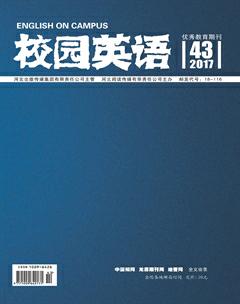A Brief Analysis of the New Translation—comparison Model
She+Ali
【Abstract】Based on pedagogy and linguistics, this paper proposes an English teaching model—new translation-comparison model and proves the validity of it. Its hoped that this model can provide some useful reference for those who dedicate to English teaching and research.
【Key words】new translation-comparison model; language transfer
1. Introduction
The latest “College English curriculum requirements” (Ministry of education, 2007) points out that the new teaching model should be “towards personaliztion and independent learning”. Based on the theories of linguistics and pedagogy, the author puts forward a set of new teaching model that can both initiate the students enthusiasm and cultivate their autonomous learning ability.
2. The Concept of New Translation-comparison Model and Its Theoretical Basis
2.1 Concepts
The new translation-comparison method is comparing the learners language with the target to find out the differences and errors so that the learners languag can be improved gradually. The main principles of the new translation-comparison method are as follows:1. the principle of constrasting the learners language (interlanguage) with the target language;2. the principle of self-correction;3. the principle of constructing actively instead of passive replication;4. the principle of independent learning;5. the principle of detecting the knowledge in social background.
2.2 The Theoretical Basis
2.2.1 Instructive principles in Pedagogy
The instructive principle (Zhu, Wang & Zhou, 2010) is a heuristic principle which plays the leading role of teachers in teaching. It arouses the students consciousness and guides them to think independently. The new translation model encourges the students learning initiative fully. The students translate the articls before class and compare it with the target langugage. More importantly, the new model teaches the students how to learn and guides the students to use their hands and brain to explore the knowledge creatively.
2.2.2 The theory of Language Transfer
The new translation-comparison model makes use of the positive transfer of language similarity. Ringbom (1987) analyzes the complexity of cross language similarity. He believes that language similarity refers to psychological similarity or perceived similarity. “Both psychological similarity and perceived similarity affect the transfer from the native language to the target languge”. (Yu, 2004) When the learners translate the given article, some structures similar to their mother tongue are easily translated and not easy to make mistakes. For example:明天我要去北京。Tomorrow I will go to Beijing. 這消息令她很愉快。The news made her very happy. From this we can see that Chinese has positive transfer to English because of the similarities between English and Chinese.
3. The Implications for Foreign Language Teaching
3.1.1 Pay Attention to the Balance of Similarities and Differences between Languages
The traditional teaching model only pays attention to the differences between the first languge and the second language. The focus of the attention is to prevent the negative transfer of the native language. This makes students resist the mother tongue subconsciously and think that the native language has a negative impact on foreign language learning. The new model not only focus on language differences, and at the same time it uses the languge similarities, which makes their teaching model more balanced. Consequently, its beneficial to enhance the students confidence in learning and motivation and finally help students learn a foreign language.
3.1.2 Proper Use of Conscious Teaching
From the psychological point of view, its necessary to explore the language similarity if the mother tongue and the target language are far in typology. The learners native language is an important and predictable system. (Zhen&Chen, 2007) In the ranslation-comparison model, the teacher encourages the students interest in language perception and maximize the use of the mother tongue.
4. Conclusion
The author thinks that the new translation-comparison model is a new teaching model based on pedagogy and linguistics after further study of teaching practice. It is beneficial to cultivate the students autonomous learning ability and promote the students enthusiasm in learning. In a word, this pattern “reflects the rules of language and language learning rules, is reasonable in theory and feasible in practice” (Chen, 2006).
References:
[1]Ringbom,H.The role of the first language in foreign language learning[M].Clevedon,Avon:Multilingual Matters,1987.
[2]陳靜.大學英語3A教學模式探索[J].外語教學,2006(5):71-73.
[3]教育部高等教育司.大學英語課程教學要求[M].上海:上海外語教育出版社,2007.

